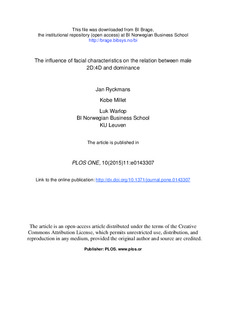| dc.contributor.author | Ryckmans, Jan | |
| dc.contributor.author | Millet, Kobe | |
| dc.contributor.author | Warlop, Luk | |
| dc.date.accessioned | 2016-01-20T13:54:38Z | |
| dc.date.available | 2016-01-20T13:54:38Z | |
| dc.date.issued | 2015 | |
| dc.identifier.citation | PLoS ONE, 10(2015)11: e0143307 | nb_NO |
| dc.identifier.issn | 1932-6203 | |
| dc.identifier.uri | http://hdl.handle.net/11250/2374390 | |
| dc.description | This is an open access journal. www.plosone.org | nb_NO |
| dc.description.abstract | Although relations between 2D:4D and dominance rank in both baboons and rhesus macaques have been observed, evidence in humans is mixed.Whereas behavioral patterns in humans have been discovered that are consistent with these animal findings, the evidence for a relation between dominance and 2D:4D is weak or inconsistent. The present study provides experimental evidence thatmale 2D:4D is related to dominance after (fictitious) malemale interaction when the other man has a dominant, but not a submissive or neutral face. This finding provides evidence that the relationship between 2D:4D and dominance emerges in particular, predictable situations and thatmerely dominant facial characteristics of another person are enough to activate supposed relationships between 2D:4D and dominance. | nb_NO |
| dc.language.iso | eng | nb_NO |
| dc.publisher | Public Library of Science | nb_NO |
| dc.title | The influence of facial characteristics on the relation between male 2D:4D and dominance | nb_NO |
| dc.type | Journal article | nb_NO |
| dc.type | Peer reviewed | nb_NO |
| dc.source.journal | PLoS ONE | nb_NO |
| dc.identifier.doi | 10.1371/journal.pone.0143307 | |
| dc.description.localcode | 1, OA | nb_NO |
